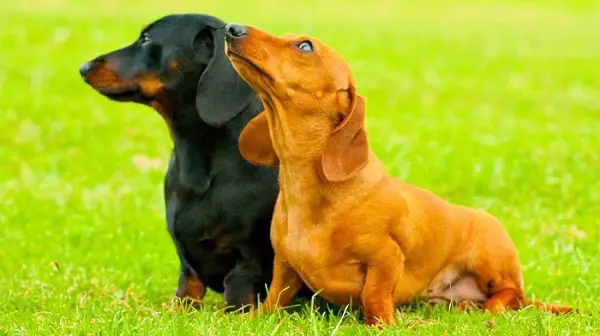Thinking of getting a dachshund and want to know more about the breed? Here’s a guide and 10 reasons you will love them!
10 Reasons To Own A Dachshund
1. They are high-spirited, stubborn, and independent, but will do what you ask with treats as they love to eat.
2. They have a long belly and love to have their bellies rubbed.
3. Dachshunds will amuse you and make you laugh with their silly looks. They look funny when they run around with their short little legs and zip all over the house.
4. The Dachshund Breed are bold and think they are big dogs. For little dogs, they have a big bark and make an excellent watchdog.
5. They have a lot of energy and can keep a good pace when you walk them.
6. They are good for snuggling up to, as they like to burrow under covers and want to be petted. With their short legs, you don’t have to worry about getting kicked while you are sleeping.
7. They love to sniff and like to dig in the yard.
8. They are intelligent and can learn different words very quickly. They have different looks that you will pick up on for knowing what they want…whether it is to take me outside, feed me, or snuggle with me.
9. The Dachshund Breed has a long life span. Some dachshunds can live up to 20 years.
10. They come in over 500 dachshund flavors.
Types of Dachshund
There are 3 coat types: smooth (short-haired), long-haired, and wire-haired.
There are 15 different color combinations: black & cream, black & tan, blue & cream, blue & tan, chocolate & cream, chocolate & tan, cream, fawn (also called Isabella) & cream, fawn & tan, red, wheaten, wild boar, black, chocolate, and fawn.
Then there are six marking combinations: brindle, dapple, sable, brindle piebald, dapple piebald, and piebald.
So doing the math there are 540 color/coat/pattern possibilities.
More Dachshund Breed Facts
The Dachshund breed has endearing traits, yet have frustrating habits as well.
You need to understand what makes the Dachshund breed tick so you know what to expect. Some of those behaviors can get on your nerves and they are one of the more stubborn breed of dogs.
The Dachshund Breed Barks
Yes, they bark and bark and bark.
The Dachshund breed can be traced to the wolves’ ancestry. Although adult wolves don’t bark, juvenile wolves bark as an alarm signal when intruders enter their den territory.
One popular theory of the dachshund breed is that they are like wolves in various stages of arrested development.
Like young wolves, adult dachshunds remain comparatively trustful, playful, dependent, obedient—and barky. All these traits made them more readily integrated into human society.
Barking in response to intruders was an especially valuable trait…a trait that is still valued in many dogs today.
The barking of a Dachshund hunting helps alert the hunter to the dog’s location, above ground or especially below.
Barking and howling serve as auditory beacons, alerting the rest of the pack to the barker’s location and drawing them all together.
This is one reason a Dachshund left alone may bark and howl until the neighbors complain.
Of course, some Dachshunds just bark for the entertainment value.
Don’t get a Dachshund if you are wanting silence. But just because it’s natural doesn’t mean you have to let your Dachshund bark excessively.
The Dachshund Breed Digs
Wild dogs dig for a number of reasons. They excavate dens in which to raise young, and they bury food for later consumption. They dig out prey. Digging is a natural and adaptive behavior.
The Dachshunds Breed Chews
Like most dogs dachshunds love to chew. So they will look for things like shoes, furniture, and pillows. It is most important to get them chew toys so they have something always to chew on.
The Dachshund Breed Sniffs
Dogs use sniffing as a way of getting to know each other, and they use it effectively to find out more about the people in their lives.
Certain parts of human and canine bodies emit more information-laden odors than others, and these parts draw your dog’s attention—as well as your embarrassment.
The Dachshund Breed Guards
Wild canines naturally protect their resources, whether food, territory, or offspring. By integrating domesticated dogs into the human family, they transferred their protectiveness to their new resources, the human’s territory, and family.
Guarding was such a valuable trait that the tendency to guard has been accentuated in many domesticated breeds.
Dachshunds are enthusiastic guardians of all things theirs, and they consider pretty much everything in sight to be theirs.
But this possessive nature can be troublesome if your dog starts guarding things from you! This is when guarding goes overboard.
Dachshunds Bite Or Can Bite
Dogs hunt, fight and protect themselves with their teeth.
Dachshunds Fight
Dogs come from a culture of both cooperation and competition.
Simply because Dachshunds have natural tendencies to act in certain ways we don’t like doesn’t mean we have to accept those behaviors as unchangeable.
But it means you need to understand that changing their behavior won’t always be easy.
Dachshunds like to fight with other dogs as they want to be naturally dominant over other dogs. They see them as threats to their dominance, intruders on their territory, or rivals for their resources.
Of course, not every aggressive encounter results in a full-blown fight.
Dachshunds communicate their aggressive intentions with growls, stares, rigid posturing, and direct confrontations, all of which give the other dog a chance to back down.
Dachshunds Roam
Wild canines have a territory over which they regularly hunt. As hunters, Dachshunds are especially likely to roam and hunt. Unfortunately, unless you live on hundreds of acres, this means wandering into roads and neighbors’ yards.
Dachshunds Hunt
Dachshunds search out, follow, and kill prey. That’s what they were bred to do. They’ll chase cats, trail rabbits, and dispatch rodents given half a chance. It’s your job not to give them that chance.
Unfortunately, young dachshunds may perfect their skills on your new shoes, antique furniture, and feather pillows.
Even adult dachshunds enjoy chewing, but usually, you can redirect it to more acceptable targets, such as chew toys and rawhides.
Dachshunds Steal
It’s not that they are kleptomaniacs. It’s that dogs evolved as hunters and scavengers.
Anything left unguarded was fair game and ended up in a smart dog’s mouth.
Fortunately, their limited reaching ability means most foods on your counter are safe as long as you push them to the rear.
As your Dachshund matures, you can teach him that items on tables are yours whether you’re around to guard them or not.
But don’t put too much credence in those innocent eyes when you come back in and can’t find that cookie you left on the coffee table.
Dachshunds Scavenge
The dog’s very first service to mankind was likely that of a garbage man, disposing of wastes that would otherwise attract less desirable scavengers. And perhaps humans’ first service to dogs was to inadvertently feed them at village dumpsites.
Your Dachshund has no way of knowing that the miniature dumpsite you call the kitchen trash can is not just for him. Your best bet is to do like most resigned dog owners…just keep the trash can under the sink.
Dachshunds Join In
Dogs are pack animals, and it’s instinctive for them to join in whatever you or your family is doing. That means he’s going to be unhappy shut in another room while you have company over, or shut home alone when you go out.
Not only is he missing out on all the fun, but from an evolutionary viewpoint, being left alone is being put in danger.
That’s why many dogs, Dachshunds included, become anxious if left by themselves.
They’ll dig, chew, bark, and do whatever they can do to bring you back or to escape and find you.
That doesn’t mean your Dachshund can’t learn to be alone, as they can be trained to avoid separation anxiety.
Dachshunds Lick
Licking is a natural dog behavior. Dogs lick one another as an appeasement gesture, often along with rolling over and giving the canine equivalent of “Uncle!”
Puppies mostly use licking to elicit regurgitation from adults, particularly from their dam, around the time of weaning.
Wild canines greet adults returning from hunting by licking at the adults’ mouths in hopes of getting a meal.
Domestic dogs continue this behavior into adulthood, licking at the mouth of dominant dogs and of humans.
When your Dachshund licks at your face when you return home, he’s not so much giving you sugar as acknowledging your leadership.

